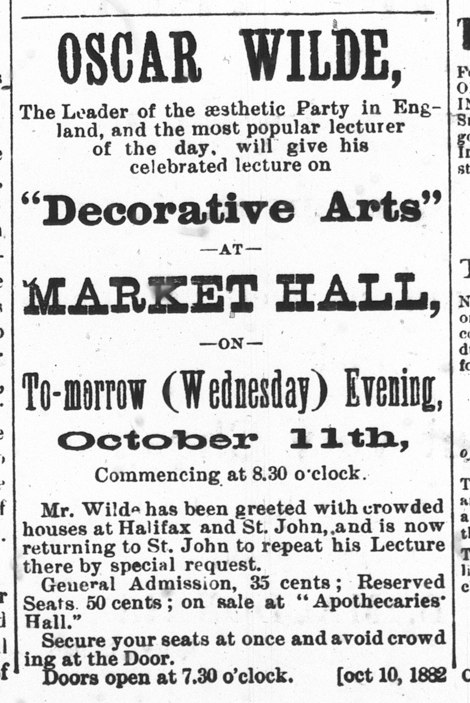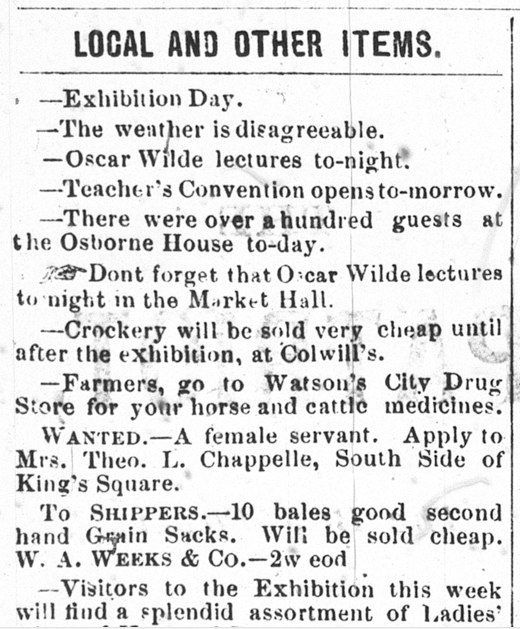In the fall of 1882 Oscar Wilde made a 9-stop tour of the Canadian Maritimes, a tour that brought him to Charlottetown on the evening of October 11, 1882 for a lecture, Decorative Arts, presented at the Market Hall. The lecture was advertised in the the local newspapers, including the Daily Patriot:

Newspapers also made editorial mention of the lecture; on October 10, 1882, this item appeared in the same Daily Patriot:
Oscar Wilde is after all coming to the Island. He is to lecture in the Market Hall to-morrow evening. There will no doubt be a great rush to hear and see the famous aesthete, and while his love of the beautiful and sense of the fitness of things will no doubt sustain many shocks in our town we think that he cannot but be pleased with the loveliness of our Island province.
The Patriot followed up the next day with a quick reminder – actually, two – in the October 11, 1882 “Local and Other Items” column, a column that also included notice of the Teacher’s Convention, Exhibition Day and disagreeable weather:

The following day, October 12, 1882, the Daily Patriot contained a report of the lecture, headed “Oscar Wilde’s Lecture,” which reads as follows:
This well advertised man lectured in the Market Hall of this city last night. Mr. Wilde affects singularity, but there did not appear to us anything very remarkable in either his dress, his personal appearance, or his lecture – certainly not enough to warrant one-tenth part of what has been said and written about him. His dress, neither in color or cut, was, as far as we could see, very different from that of ordinary young Englishmen. He evidently had on his ordinary travelling suit. It was grey, relieved by a bit of color at the neck and breast. He wore knee breeches which were decidedely baggy at the knees, and his blue stockings, although they displayed a well-shaped calf, were not at all different from the stockings we have seen on other young fellows. Mr. Wilde wears his hair long, but we saw not long ago a Quebec pilot with a longer and a handsomer head of hair, and his head, either for shape or covering, would not compare too favorably with that of a western Indian whom it was our privilege to see some time ago. Mr. Wilde is too effeminate in his appearance to be a handsome man, and he is too masculine to pass for a good looking woman.
His style of speaking is consistent with his personal appearance. It is odd, without being either very strong or very beautiful. His attitudes are not exceedingly graceful, particularly when he places his hands on his hip, as he is apt to do, and makes a handle to himself of his arm. He does not gesticulate much, but if he raised his other arm high enough he would not in that attitude make a bad model for an aesthetic coffee pot. Affectation is Oscar Wildes strong point – affectation in dress, affectation in manner and affectation in speech. His want of naturalness is we think, what affects many people so disagreeably when they hear him for the first time and causes them to rage against him so violently.
His lecture is a good lecture enough. It is a discourse teaching that honesty, sincerity, and fidelity to nature are the foundation of beauty in art, and that men would be wiser, better and happier than they are if they were surrounded from their childhood by things that are really beautiful. Mr. Wilde attributes a moral influence to the design and the tints of a wall paper, to the pattern and color of a carpet, to the form of a water jug, to the shape and ornamentation of a stove, and so on, of all common things by which we are surrounded. He believes because of the moral as well as the intellectual influence of beauty, they should all be as beautiful as the most cultivated taste can make them. We are not sure that he is not, to a certain extent, right. A thing of beauty is a joy forever for human beings of all ages, and all races, but men differ widely in their ideas of what is beautiful. Mr. Wilde teaches that nature in all her aspects is beautiful, and if his theory of the moral influences of beauty is true, those who live most of their time under nature’s covering and surrounded by nature’s works – the American Indian and the Afcrian negro for example – will be the most refined as well as the best of the children of men. Is this so? Mr. Wilde’s gospel of beauty like all other human gospels needs, we fear, a good deal of qualifying. One part of Mr. Wilde’s lecture deserves the serious attention of all parents and every one who has to do with the education of children, and that is, where he insists upon the necessity of teaching boys and girls of all ranks in life to use their hands. The number of men and women who are brought up in these days without learning to use their hands in any useful way is absolutely appalling. When reverses come upon these handless people, and when they are placed in a postiion – as nearly every man is at some period of his life – where his intellectual acquirements are of little use to him and where his very existence depends upon a more or less skillful use of his hands, he is the most helpless, and the most pitiable of creatures. No boy or girl is any the worse for learning some handicraft. Acquiring it will not retard, but assist his merely intellectual education. He will always be better of having learned it and it may be of the very greatest use to him. Mr. Wilde’s lecture teaches what many people to it hard to understand – the use of beauty.
Oscar Wilde was 27 years old at the time of his visit – he turned 28 the following week. The next evening he was in Moncton, then Saint John to finish, and on to New York City where he spent 10 weeks “flitting restlessly from hotel to hotel” and had all manner of adventures. On December 27, 1882 he sailed for London, a departure the New York Tribune reported like this:
Oscar Wilde has abandonded us without a line of farewell, slipped away without giving us a last goodly glance, left without a wave of his chiseled hand or a friendly nod of his classic head. This is the end of the aesthetic movement.
Oscar Wilde never returned to Charlottetown.
Credit to Declaring His Genius: Oscar Wilde in North America and to Catherine Hennessey, who first blogged about Wilde’s visit to Charlottetown 13 years ago.
 I am
I am
Comments
Oscar Wilde’s American tour
Oscar Wilde’s American tour has a website all its own.
Add new comment